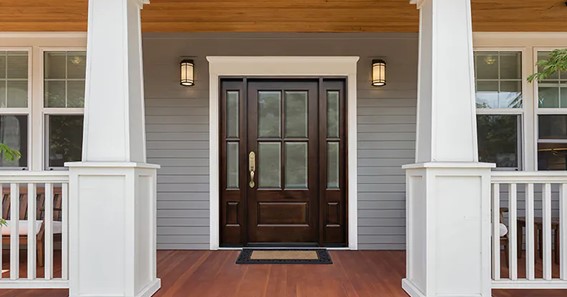Are you curious to know what is flush door? You have come to the right place as I am going to tell you everything about flush door in a very simple explanation. Without further discussion let’s begin to know what is flush door?
When it comes to interior design and architecture, doors play a crucial role in defining the style and functionality of a space. Among the various types of doors available, flush doors have gained popularity for their sleek and modern appearance, durability, and versatility. In this blog, we will delve into the concept of flush doors, their construction, benefits, and their role in enhancing both residential and commercial spaces.
What Is Flush Door?
Flush doors are contemporary-style doors that feature a smooth and flat surface, with no raised or recessed panels. They are designed to seamlessly blend with the surrounding walls, creating a clean and minimalistic look. Flush doors are commonly made by enclosing a honeycomb or solid core between two face panels, which can be constructed using a variety of materials such as plywood, medium-density fiberboard (MDF), or wood veneers.
Benefits Of Flush Doors:
-
Sleek and Modern Aesthetics:
Flush doors are known for their clean and minimalist appearance, making them an ideal choice for contemporary and modern interior designs. The absence of intricate detailing or raised panels allows them to blend seamlessly with the overall decor, providing a sleek and unobtrusive look.
-
Versatility in Design:
Flush doors offer versatility in terms of finishes and materials. They can be customized with different veneers, laminates, paints, or stains to match various architectural styles and design preferences. From natural wood finishes to bold colors or textures, flush doors can be tailored to suit any interior aesthetic.
-
Durability and Stability:
Flush doors are designed to be robust and long-lasting. The construction with a solid or honeycomb core, sandwiched between face panels, provides strength and stability. This makes flush doors resistant to warping, cracking, and other forms of damage, ensuring their durability over time.
-
Ease of Maintenance:
The smooth and flat surface of flush doors makes them easy to clean and maintain. Unlike doors with intricate panel designs that can collect dust or debris, flush doors can be wiped clean effortlessly, saving time and effort in upkeep.
-
Sound and Thermal Insulation:
Flush doors with a solid core offer excellent sound and thermal insulation properties. The dense core material helps reduce noise transmission between rooms and enhances energy efficiency by providing a barrier against heat transfer. This contributes to a more comfortable and peaceful living or working environment.
Applications Of Flush Doors:
Flush doors find extensive use in both residential and commercial settings:
-
Residential Spaces:
In homes, flush doors are commonly used for interior applications such as bedrooms, bathrooms, closets, and utility rooms. They provide privacy, enhance aesthetics, and seamlessly integrate with modern interior designs.
-
Commercial and Office Spaces:
Flush doors are popular in commercial settings, including office buildings, hotels, retail stores, and public institutions. Their sleek appearance and versatility make them suitable for a wide range of applications, from private offices to common areas and meeting rooms.
-
Institutional and Healthcare Facilities:
Flush doors are preferred in educational institutions, healthcare facilities, and laboratories due to their durability, ease of maintenance, and ability to withstand heavy usage. They can be fire-rated and designed to meet specific safety and regulatory requirements.
Conclusion:
Flush doors exemplify the perfect blend of functionality and aesthetics, offering a sleek and modern design while providing durability and versatility. Their clean and minimalistic appearance allows them to seamlessly integrate with a variety of architectural styles and interior designs. Whether in residential or commercial spaces, flush doors contribute to the overall aesthetic appeal while providing privacy, sound insulation, and durability. With their numerous advantages, flush doors continue to be a popular choice for those seeking a contemporary and timeless solution for their interior door needs.
You can gather more stuff on Caresclub
FAQ
What Makes A Flush Door?
A flush door is a door that has plain facings on either side you approach it from. People tend to use flush doors for more “functional” uses rather than trying to make a statement. They are also more commonly used indoors rather than outdoors. Their design is normally very straightforward but practical.
What Are The Disadvantages Of A Flush Door?
Disadvantages/Cons:
Plywood covered flush door cannot be used where they will be exposed to rain and the sun. The biggest disadvantage for a solid core door is that it is heavy. So it is difficult to handle and transport to your home.
What Is The Difference Between Solid Core And Flush Door?
Solid core doors are strong and have better sound proofing properties. The laminated flush doors consist of stiles, top and bottom rails each not less than 7.5cm wide. Solid core doors are made from combination of blockboard/ Particle Board/Medium Density Fibreboard (MDF) /Laminated Core, cross band, face veneer, etc.
What Is The Difference Between A Flush Door And A Ply Door?
Which is a heavier flush door or ply door? Plywood is usually made from hardwood, which makes the board very heavy. So plywood doors are much heavier than flush doors (they have softwood blocks inside). Heavy doors can be very difficult to carry, install, and operate in everyday use.
I Have Covered All The Following Queries And Topics In The Above Article
What Is A Flush Door
What Is Flush Door Made Of
What Is Flush Door In India
What Is Flush Door And Panel Door
What Is A Flush Door In Construction
What Is Flush Door?
What Is Flush Panel Door
What Is Flush Door Plywood
What Is The Difference Between Flush Door And Panel Door
What Is A Flush Panel Door
What Is Flush Door Shutters
What Is The Difference Between A Panel Door And A Flush Door
What Is A Flush Door?
What Is Flush Door
What is the difference between a flush door and a normal door
What is use of flush door





